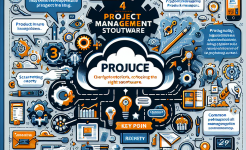Effective communication is the cornerstone of a successful Integrated Product Development (IPD) process. In an IPD environment, multiple cross-functional teams with diverse expertise come together to develop products. This collaborative effort requires seamless information flow, clear understanding of goals, and strong interpersonal relationships, all of which are facilitated by proper communication strategies and skills. Without effective communication, misunderstandings can occur, timelines can be disrupted, and the overall quality of the product may be compromised.
In an IPD process, communication is not just about sharing information; it's about ensuring that the right information reaches the right people at the right time in the right format. Different stakeholders, such as engineers, marketers, and project managers, have different communication needs and styles. For example, engineers may focus on technical details, while marketers are more concerned with market trends and customer preferences. Therefore, understanding these differences and adapting communication approaches accordingly is crucial for the success of the IPD process.
Moreover, communication in IPD is a continuous process that spans from the initial concept generation to the post-launch evaluation. At each stage, different types of communication are required to keep everyone informed, engaged, and aligned towards the common goal of developing a successful product. This article will explore various communication strategies and skills that can enhance the efficiency and effectiveness of the IPD process.
Understanding Stakeholder Communication Needs
The first step in developing effective communication strategies in the IPD process is to understand the communication needs of different stakeholders. Stakeholders in an IPD project include internal teams such as R&D, marketing, sales, manufacturing, and external parties like customers, suppliers, and partners. Each group has unique interests, concerns, and information requirements.
For internal teams, R&D may need detailed technical specifications and feedback on the feasibility of design concepts. They are often focused on the technological aspects of the product development, such as component performance and system integration. Marketing teams, on the other hand, require market research data, competitor analysis, and information about the product's unique selling points. They need to communicate effectively with R&D to ensure that the product meets market demands.
External stakeholders also play a vital role. Customers can provide valuable insights into their needs and pain points, which are essential for product development. Suppliers need clear information about product requirements, delivery schedules, and quality standards. Partners may require information about joint marketing plans, revenue sharing, and product integration. By understanding these diverse needs, project managers can tailor communication messages to ensure that they are relevant and useful to each stakeholder group.
Establishing Clear Communication Channels
Once the communication needs of stakeholders are understood, the next step is to establish clear and efficient communication channels. In an IPD process, there are various channels available, each with its own advantages and limitations. These channels can be broadly classified into formal and informal channels.
Formal communication channels include project meetings, status reports, and official documentation. Project meetings are an important platform for teams to discuss progress, issues, and decisions. They should be well-structured, with a clear agenda and time limits. Status reports provide a regular update on the project's progress, highlighting key milestones, achievements, and challenges. Official documentation, such as product specifications and design documents, serves as a reference for all stakeholders and ensures consistency in the development process.
Informal communication channels, such as hallway conversations, instant messaging, and social media platforms, also play a crucial role. These channels can help build relationships, share ideas quickly, and address minor issues in a timely manner. For example, an engineer may use instant messaging to quickly get clarification from a colleague on a technical issue. However, it's important to ensure that informal communication is still professional and relevant to the project. By using a combination of formal and informal channels, teams can ensure that communication flows smoothly and effectively throughout the IPD process.
Active Listening and Feedback
Active listening is a fundamental communication skill that is essential in the IPD process. When team members listen actively, they not only hear the words being spoken but also understand the underlying meaning, emotions, and concerns of the speaker. This helps in building trust, resolving conflicts, and making better decisions.
In an IPD project, active listening can be practiced in various ways. For example, during meetings, team members should give their full attention to the speaker, maintain eye contact, and avoid interrupting. They can also ask clarifying questions to ensure that they understand the message correctly. By demonstrating that they are listening, team members make the speaker feel valued and respected, which in turn encourages open and honest communication.
Feedback is also an important part of the communication loop. Providing timely and constructive feedback helps in improving performance, correcting mistakes, and aligning expectations. In the IPD process, feedback should be specific, objective, and focused on behavior rather than personal characteristics. For example, instead of saying "You're not doing a good job," it's better to say "The last report you submitted had some inaccuracies. Let's work together to ensure that future reports are more accurate." By giving and receiving feedback in a positive and respectful manner, teams can continuously improve their communication and collaboration skills.

Non-Verbal Communication
Non-verbal communication, including body language, facial expressions, and tone of voice, can have a significant impact on how messages are received in the IPD process. In fact, research has shown that a large portion of communication is non-verbal. Therefore, being aware of non-verbal cues and using them effectively is crucial for successful communication.
Body language can convey confidence, interest, or disinterest. For example, standing up straight, making eye contact, and using open gestures can show that a person is engaged and confident in what they are saying. On the other hand, slouching, avoiding eye contact, or crossing arms may indicate disinterest or defensiveness. In an IPD meeting, being mindful of body language can help team members build better relationships and convey their messages more effectively.
Facial expressions also play an important role. A smile can create a positive and friendly atmosphere, while a frown or a scowl can make others feel uncomfortable. Tone of voice can also change the meaning of words. For example, a statement can sound sarcastic or sincere depending on the tone used. In the IPD process, being aware of these non-verbal cues and using them to enhance communication can lead to better understanding and collaboration among team members.
Cultural Considerations in Communication
In today's globalized world, IPD projects often involve teams from different cultural backgrounds. Cultural differences can significantly impact communication styles, values, and expectations. Therefore, it's important to consider cultural factors when developing communication strategies in the IPD process.
For example, in some cultures, direct communication is preferred, while in others, indirect communication is the norm. In a direct communication culture, people tend to say what they mean clearly and straightforwardly. In an indirect communication culture, people may use more subtle cues and hints to convey their messages. Understanding these differences can prevent misunderstandings. For instance, a team member from a direct communication culture may misinterpret the indirect communication of a colleague from an indirect communication culture as being evasive or untruthful.
Cultural values also play a role. Some cultures value individualism, while others emphasize collectivism. In an individualistic culture, people may be more focused on their own achievements, while in a collectivistic culture, the group's goals and harmony are prioritized. This can affect how teams work together and communicate. By being aware of these cultural differences and adapting communication styles accordingly, teams can overcome cultural barriers and work more effectively towards the common goal of product development.
Conflict Resolution through Communication
Conflicts are inevitable in any IPD project due to differences in opinions, interests, and work styles. However, how conflicts are managed can have a significant impact on the project's success. Effective communication is the key to resolving conflicts in a constructive manner.
When a conflict arises, the first step is to create a safe and open environment for communication. All parties involved should feel comfortable expressing their views and concerns without fear of judgment or retaliation. This can be achieved by setting ground rules for communication, such as listening without interrupting and focusing on the issue rather than the person.
Once everyone has had a chance to express their views, the next step is to find common ground. By identifying shared goals and interests, teams can work towards a solution that satisfies everyone. This may involve brainstorming ideas, evaluating different options, and reaching a compromise. Through effective communication, conflicts can be turned into opportunities for growth and improvement in the IPD process.
Conclusion
In conclusion, communication strategies and skills are of utmost importance in the IPD process. Understanding stakeholder communication needs, establishing clear communication channels, practicing active listening and feedback, being aware of non-verbal communication, considering cultural factors, and resolving conflicts through communication are all essential elements for the success of an IPD project.
By implementing these strategies and skills, teams can enhance information flow, build stronger relationships, and improve collaboration. This, in turn, leads to more efficient product development, better quality products, and increased customer satisfaction. In the complex and dynamic environment of IPD, effective communication is not just a nice-to-have but a necessity for achieving project goals and staying competitive in the market.
Project managers and team members should continuously invest in developing and improving their communication skills. This can be done through training, practice, and self-reflection. By making communication a priority, organizations can create a culture of open and effective communication, which will benefit not only the IPD process but also the overall success of the business. As the business landscape continues to evolve, the ability to communicate effectively in the IPD process will remain a critical factor for organizations to thrive.
ARTICLE TITLE :Communication strategies and skills in IPD process ,AUTHOR :ITpmlib

















